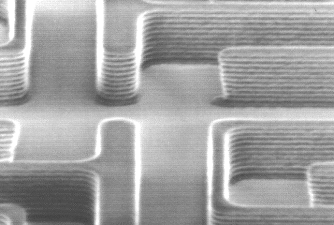Another important aspect of photoresist exposure is the standing wave effect. Monochromatic light, when projected onto a wafer, strikes the photoresist surface over a range of angles, approximating plane waves.
This light travels down through the photoresist and, if the substrate is reflective, is reflected back up through the resist. The incoming and reflected light interferes to form a standing wave pattern of high and low light intensity at different depths in the photoresist. This pattern is replicated in the photoresist, causing ridges in the sidewalls of the resist feature as seen in Figure 1-6. As pattern dimensions become smaller, these ridges can significantly affect the quality of the feature. The interference that causes standing waves also results in a phenomenon called swing curves, the sinusoidal variation in line width with changing resist thickness.
These detrimental effects are best cured by coating the substrate with a thin absorbing layer called a bottom antireflective coating (BARC) that can reduce the reflectivity seen by the photoresist to less than 1 percent. The exposure parameters required in order to achieve accurate pattern transfer from the mask to the photosensitive layer depend primarily on the wavelength of the radiation source and the dose required achieving the desired properties change of the photoresist. Different photoresists exhibit different sensitivities to different wavelengths. The dose required per unit volume of photoresist for good pattern transfer is somewhat constant; however, the physics of the exposure process may affect the dose actually received. For example a highly reflective layer under the photoresist may result in the material experiencing a higher dose than if the underlying layer is absorptive, as the photoresist is exposed both by the incident radiation as well as the reflected radiation. The dose will also vary with resist thickness. There are also higher order effects, such as interference patterns in thick resist films on reflective substrates, which may affect the pattern transfer quality and sidewall properties.
At the edges of pattern light is scattered and diffracted, so if an image is overexposed, the dose received by photoresist at the edge that shouldn’t be exposed may become significant. If we are using positive photoresist, this will result in the photoresist image being eroded along the edges, resulting in a decrease in feature size and a loss of sharpness or corners. If we are using a negative resist, the photoresist image is dilated, causing the features to be larger than desired, again accompanied by a loss of sharpness of corners. If an image is severely underexposed, the pattern may not be transferred at all, and in less severe cases the results will be similar to those for overexposure with the results reversed for the different polarities of resist.
Figure: Photoresist pattern on a silicon substrate showing prominent standing waves.
